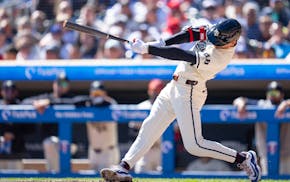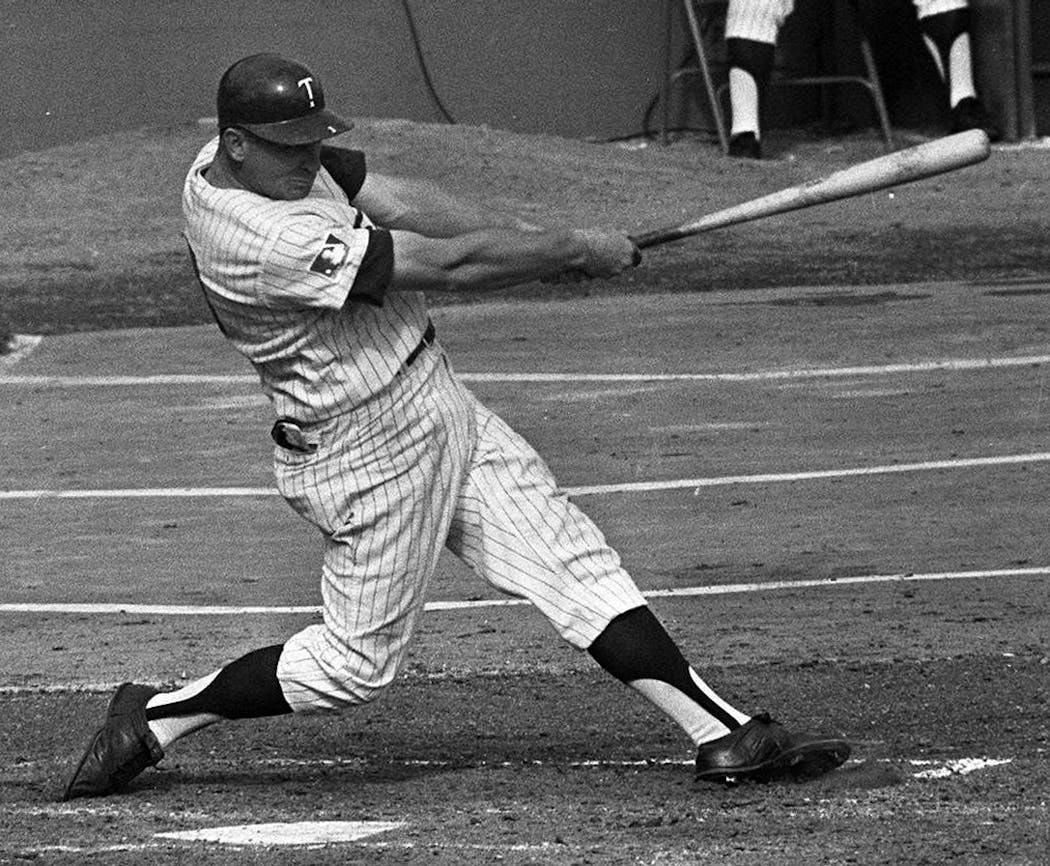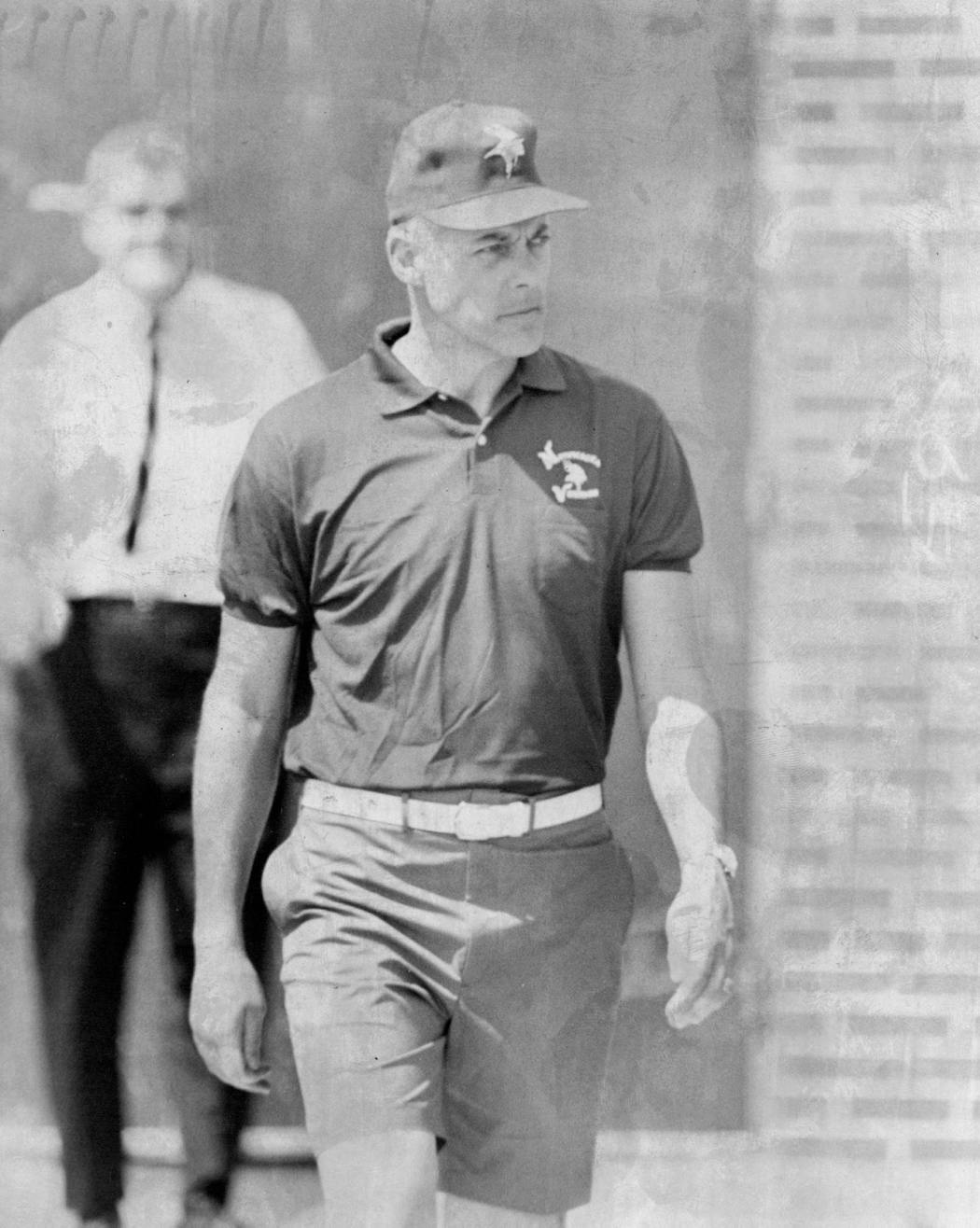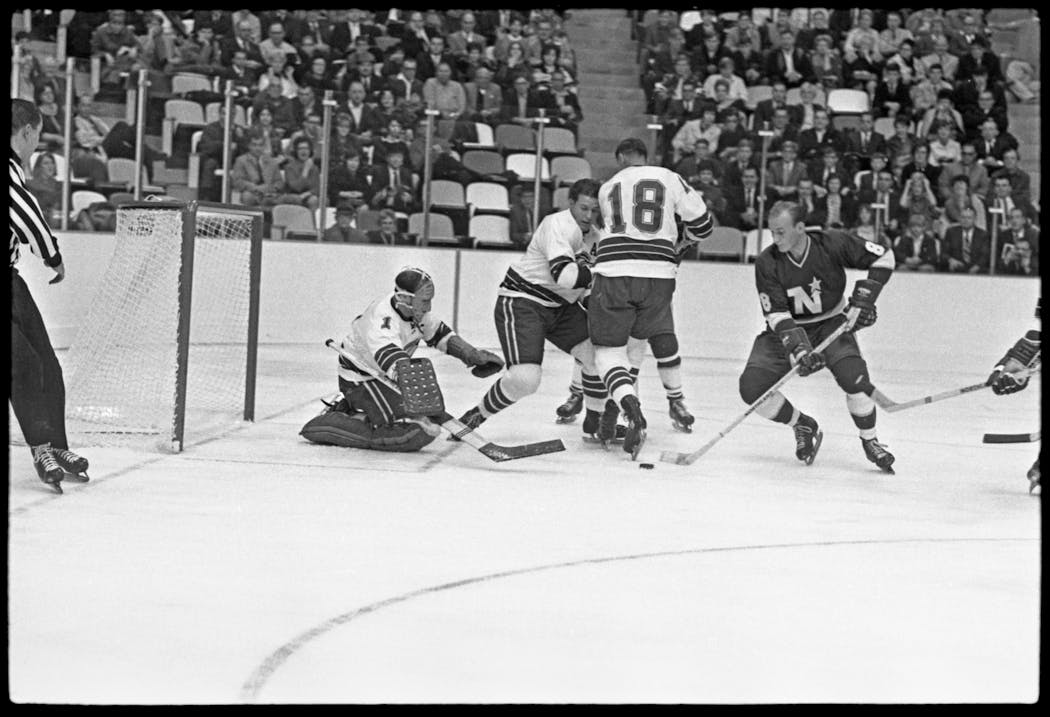We hit the big time, finally, 50 years ago. We were finally a major league sports market. But, boy, it was not easy. We scrambled to get the new hockey arena ready for the new hockey team, and pro basketball returned, left, returned and left again, not to be seen for another 20 years. And if that chaos wasn't enough, the Twins flamed out at the finish of one of baseball's all-time great pennant races, while our football teams endured both the birth of a legend and the end of a legendary run. Chaos, yes, that's a good word to describe 1967. Patrick Reusse remembers it all.
1967 TWINS FELL SHORT OF A PENNANT AT THE WIRE
The 2017 Twins are involved in a chaotic competition of flawed, feisty teams to claim the American League's second wild card and earn a chance to play in a single-elimination game on the road.
The standards were higher and the stakes much greater when the 1967 Twins engaged in an ever-changing duel among four of the AL's 10 teams. The winner would advance to the World Series to play St. Louis, the runaway leader in the National League.
The media label for this pursuit came easily: "The Great Race" was a popular movie in 1965, and now there was a Great Race that would bring disappointment in Minnesota, Detroit and the South Side of Chicago, and invigorate a Boston baseball scene so moribund that there had been veiled threats the Red Sox might join the Braves (1953 to Milwaukee) in leaving town.
The Twins had stumbled at the start of 1967. The crowds had turned painfully small and owner Calvin Griffith was in a bad mood.
On June 8, bullpen stopper Al Worthington gave up four runs in the ninth and the Twins lost 7-5 to Cleveland. This put the Twins at 25-25 and in sixth place.
Griffith fired Sam Mele the next day after six-plus years as manager and brought in Cal Ermer, his manager at Class AAA Denver. Calvin said he was reacting to Twins fans' wishes, claiming he had received "400 letters" urging Mele's firing.
The fans not buying tickets probably had more to do with it — as did a clubhouse with veterans who seemingly had tired of Mele. As proof, the players didn't include Mele (managers were eligible then) when voting potential World Series shares in mid-September.
The Twins were hanging around .500, until they went on a 14-3 run that put them within a half-game of first place in mid-July.
Then, kaboom! The Twins went 0-7-1 over an eight-game stretch. Fifty years later, Jim Kaat still laments one pitch from the tie on July 25 in Yankee Stadium.
"I was ahead 1-0 with two outs in the ninth, pitching to Mickey [Mantle]," Kaat said. "I didn't like catchers coming to the mound, but with a 3-1 count, Russ Nixon came out and asked what I wanted to do with Mick. I said, 'I want to pitch to him, because Elston Howard's next, and he gives me more trouble.'
"Well, Mickey homered, the weather rolled in, and we made up the tie when we went back to New York. I gave up one run again, and lost 1-0 to Steve Barber."
Kaat paused and said: "That tie could've been the pennant."
The Twins rallied after leaving New York. They swept the White Sox in an August series that drew 115,000 to Met Stadium and took first place for the first time.
Calvin was smiling, and the four-team brawl was full steam ahead. On Sept. 6, the Twins, White Sox, Red Sox and Tigers were tied for first in games behind, all either 79-62 or 78-61.
The White Sox dropped out Sept. 29, the Friday of the final weekend. The Twins had games in Boston on Saturday and Sunday. The Tigers had two rainouts, leaving them with home doubleheaders vs. the Angels on those same days.
The Twins needed one victory in Fenway. Kaat was pitching Saturday and said, "I had been as close to Sandy Koufax as I ever was going to get that September. Best I ever pitched in my life."
Kaat was leading 1-0 in the third inning when his elbow popped and he had to leave. It was a tendon tear.
The Twins lost that game 6-4, with Carl Yastrzemski hitting a three-run homer. Dean Chance was making his third start in a week on Sunday and the Twins lost again 5-3. Yaz had four hits and threw out Bob Allison at second to kill an eighth-inning rally.
The Tigers lost the second game to the Angels later that day, and Boston had won the pennant.
In New England, the song title "Impossible Dream" was used to describe the city's baseball rebirth. In Minnesota, it was a bad ending to a Great Race.
BIG TEN TITLE COST GOPHERS A ROSE BOWL
College football was a far different world in 1967. There were the four traditional New Year's bowls with the Rose, Sugar, Orange and Cotton, and only four others with the Gator, Sun, Liberty and Bluebonnet.
Oddly, there were 10 teams in the Big Ten, and they were eligible only to play in the Rose Bowl. There was also a no-repeat rule in effect for teams representing the Big Ten in Pasadena from 1963 to 1972.
From 1960 to '62, the Gophers were 17-4 in the Big Ten, 22-6-1 overall (including 1-1 in Rose Bowls) and were voted as 1960 national champions.
The following four seasons for coach Murray Warmath resulted in a 17-19-2 record. This started a steady decline in attendance, leading to crowds in the low 40,000s at Memorial Stadium for nonconference victories over Utah and SMU in 1967.
The Gophers opened Big Ten play that season with four straight victories. Linemen John Williams, McKinley Boston and Bob Stein and back Tom Sakal were stars of a stout defense. On offense, Warmath stuck with a previously stated theory: "There are three things that can happen when you pass and two of them are bad."
The Gophers threw 182 passes and rushed 517 times, mostly behind fullback Jim Carter, halfback George Kemp and quarterback Curtis Wilson.
The Big Ten title race came down to favorite Purdue, the Gophers and upstart Indiana. And there was this twist: Purdue was not eligible to go to the Rose Bowl. A year earlier, Purdue had gone to Pasadena as the Big Ten runner-up, since 1966 champion Michigan State went after the '65 season.
I'm not putting you on here. Fifty years ago, bowl games were seen as unneeded interruptions in a school's educational mission in the haughty Big Ten.
The Gophers were pummeled 47-12 at Purdue in a game of conference unbeatens on Nov. 11. A week later, the Gophers thrashed Indiana 33-7 at Memorial Stadium.
That put the Gophers in this strange position entering the final Saturday: They could root for Purdue to beat Indiana and get a trip to the Rose Bowl as Big Ten runners-up, or they could root for Indiana to beat Purdue and get a three-way tie for the Big Ten championship — an outcome that would send Indiana to the Rose Bowl, based on the Hoosiers never having been the Big Ten representative.
The Gophers did their part, beating Wisconsin 21-14, but Indiana shocked No. 3 Purdue 19-14.
Apparently, the Gophers preferred a solo title for the Boilermakers.
"I've never heard a quieter dressing room after a victory," Warmath said. "I'm happy that we tied for the championship, but also disappointed because the boys wanted that last game in Pasadena on Jan. 1 and they won't get it."
VIKINGS GLORY YEARS BEGAN WITH BUD GRANT'S ARRIVAL
There had been only hints in the Twin Cities media of the loathing that Vikings coach Norm Van Brocklin and quarterback Fran Tarkenton had developed for one another during their six-year association.
The veil of semi-secrecy was lifted on Dec. 4, 1966, when the new expansion team, Atlanta, faced the Vikings at Met Stadium. The vindictive Van Brocklin benched Tarkenton against his hometown team and turned the game (a 20-13 loss) over to backup Bob Berry.
The coach and QB had a seven-hour sit-down after the season. No peace was made. Tarkenton wrote a letter of "resignation" to the Vikings. Van Brocklin then resigned on Feb. 11.
Tarkenton still wanted a trade, and GM Jim Finks still wanted to trade him. Tarkenton was sent to the New York Giants on March 6 for draft choices that brought Clint Jones, Gene Washington and Bob Grim in 1967, and Hall of Famer Ron Yary in 1968. Finks also acquired a Rams pick in 1967 that brought Alan Page.
Finks didn't require a wide search for a coach. He had been in the Canadian Football League and wanted Bud Grant, already a CFL coaching legend at 39 with the Winnipeg Blue Bombers.
"Go to the airport and pick up Bud Grant," Finks told Bill McGrane, his public relations man. "He'll be the one who looks like the town marshal."
Grant was named as coach on March 11. Three days later, the rebuilding of the Vikings started with the draft.
Bud was familiar as a former Gopher and Minneapolis Laker. Still, there was an odd quality to this new coach. We scoffed loudly when he had Fred Cox kick a 21-yard field goal with the Vikings trailing the Los Angeles Rams 32-0 early in the fourth quarter of his second game.
The 1967 Vikings finished 3-8-3. "Tie one for Bud!" was a sarcastic motto offered by fans.
Two years later, quarterback Joe Kapp came up with "40 for 60!" — 40 players for 60 minutes — as the 1969 Vikings went to the Super Bowl. There would be three more, after Tarkenton returned in 1972 to be the quarterback for a steely-eyed coach with whom he was compatible.
SUCCESS, TRAGEDY IN NHL'S FIRST SEASON
The NHL doubled in size on Feb. 9, 1966, when owners of the original six teams approved an expansion West Division. The new franchises were awarded to Minnesota, Philadelphia, Pittsburgh, St. Louis, Los Angeles and Oakland.
The entry fee was $2 million, plus $50,000 per player to select 20 players in the expansion draft in June 1967. The Minnesota owners also went to work rushing to build Met Center, a $6.5 million arena in the parking lot to the north of Met Stadium.
Mike Lamey revealed in the Minneapolis Star that General Manager Wren Blair and the North Stars had spent $100,000 scouting talent over the winter. And when doing so, Blair and five of his scouts — including Walter Bush, the team president — were taking newfangled tape recorders into arenas.
Blair and his staff had access to "over 100 tapes" evaluating players as they readied for the expansion draft. Cutting edge, 1967-style.
The North Stars opened with a 2-2 tie in St. Louis on Oct. 11, with Bill Masterton scoring the franchise's first goal. Three months later, he would die on the ice at Met Center, after hitting the back of his head on the ice. The NHL has a Masterton Memorial Trophy that honors perseverance, sportsmanship and dedication.
The North Stars were 0-2-2 when they arrived for the home opener Oct. 21. The scoreboard still was being installed and other details being completed earlier that Saturday. The Minneapolis Morning Tribune also was two articles into an eight-part series on "the best ways to watch the National Hockey League," written by newly appointed writer Dwayne Netland. The intricacies of "offsides" and "icing" were being explained to the hockey rubes in a Minnesota readership.
The North Stars won that night 3-1, with Ray Cullen getting a tiebreaking goal early in the third period. The crowd of 12,951 was the largest of six home openers for the expansion teams.
Seven months later in St. Louis, Ron Shock scored at 2:50 of the second overtime to give the Blues a 2-1 victory over the North Stars in the seventh game of the West Division finals.
Five of those games were played in St. Louis, because of a previously scheduled event at Met Center. This allowed the North Stars to immediately join the club of Minnesota sports teams that never catch a break … right, fans?
FANS DIDN'T PONY UP FOR NBA PRETENDER
There were 10 teams in the NBA in early 1967, when Californians Dennis Murphy and Gary Davidson announced plans to start a new league, the American Basketball Association, in the fall.
The ABA announced 11 franchises in April, including a team in the Twin Cities called the Minnesota Muskies. The Minneapolis Lakers had left for Los Angeles in 1960 and were a power in the NBA, and now pro basketball would be represented here by an impostor of a major league.
That was the public perception from the start. The Muskies hardly created a ripple with ticket buyers, even with Lakers great Jim Pollard as coach and Mel Daniels, a future Basketball Hall of Famer, as a mighty big man.
The Muskies finished the 1967-68 season at 50-28, won a five-game quarterfinal series with the Kentucky Colonels and then were beaten 4-1 in the Eastern Division finals by the Pittsburgh Pipers and Connie Hawkins.
You want chaos? In the months after that first season, the Muskies moved to Miami to become the Floridians, and the Pipers moved here to play at Met Center, only to move back to Pittsburgh after the 1968-69 season.
Eddie Holman, an ownership partner and general manager of the Muskies, owned a bulk oil company. As a sports executive, he was a novice, and quite a character.
The promotion for the home opener on Oct. 22, 1967, was to give away a Shetland pony at halftime. The winner was Tim Hageman, a 13-year-old who lived in south Minneapolis.
Can't you see it? Mom: "How was the game?" Tim: "Great, Mom. I won a horse."
Four days later, the Muskies lost 115-96 to the Anaheim Amigos and Holman immediately announced a $25 fine for all of the players. A few days later, he rescinded the fines, "if there isn't a repeat of this shoddy performance during the rest of the season."
Too bad GM Holman didn't have a larger audience, because his antics were worth many eye rolls and laughs during that one, lonely season for the Muskies.

Live: Minnesota United at Charlotte FC. Follow on Gameview.
Jameson Taillon comes off the injured list and helps the Cubs beat the Marlins 8-3
T-wolves take NBA's best defense into series vs. Suns, but can it stop Durant-Booker-Beal trio?







